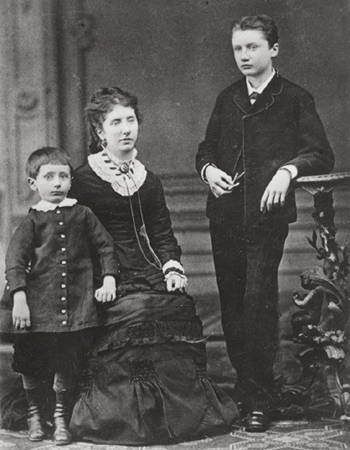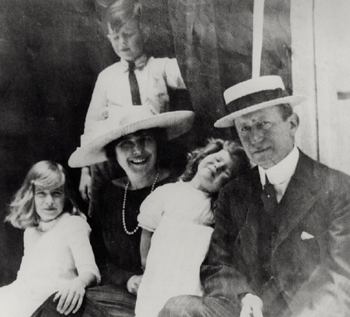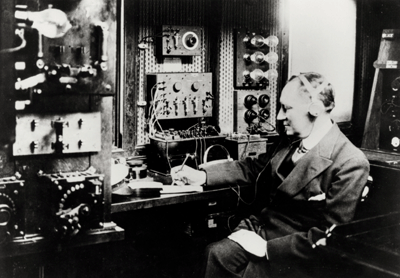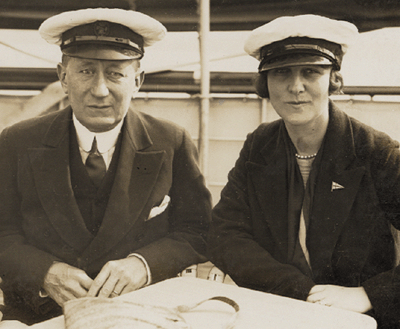A lack of formal education, high-powered family connections and an unstoppable will to succeed helped Guglielmo Marconi to transmit the first radio signal across the Atlantic and launch the wireless-communications industry.

There cannot be many people who screwed up at school, failed to get into university, and then went on to win a Nobel Prize for Physics. But at least one did, and with good reason: he made radio happen. In a few years of manic activity, Guglielmo Marconi managed to transform an obscure piece of maths into a social upheaval that makes the dot.com phenomenon look about as radical as a new bike for your postman.
Marconi’s 1909 Nobel prize seems all the more extraordinary when you consider that – unlike the physicist he shared it with, Ferdinand Braun – Marconi was not, by his own admission, any kind of scientist, or even much of an inventor. He did not really make any fundamental discoveries, and radio was mostly a matter of assembling parts created by other people. But the vision needed to see the possibilities of a new era of communication, and the unstoppable will to pursue it, were all his own. No intellectual, Marconi earned his Nobel prize the hard way by dragging a great chunk of physics out of the lab and holding it up for the world to see, approve and, more importantly, buy.
It was all a long time ago. In fact it is 100 years since Marconi proved, contrary to informed opinion at the time, that wireless waves could cross the Atlantic. Since then, radio has undergone a bumpy ride in the fashion stakes. Some 40 years ago, it was seen as ancient history and distinctly uncool, despite the invention of the transistor. Computers were the upcoming thing for ambitious scientists and engineers. Digital chips were hip; coils and capacitors were not.
But radio never went away, and today it is chic and centre stage again. It even gets called “wireless” by a generation that no longer associates the word with a wooden box that took ages to warm up. Bluetooth wireless technology may one day allow every conceivable electronic gadget to talk effortlessly to every other, while digital transmission is revolutionizing television and will do the same for sound as soon as someone markets a receiver that does not require a second mortgage.
But the radio application that’s had more impact than any other is, of course, the mobile phone. And, in a satisfying display of closure, this three-way marriage of radio, computers and the fixed phone network has enabled millions of texting teenagers to put life back into the concept that started it all: wireless telegraphy.
Making waves
So just how did “wireless” and “telegraphy” get together? Like a horseless carriage, a wireless telegraph proposes to do away with the very thing that makes the technology work. Pursuing an idea like this demands the ability to enter a new world, not just optimize an old one. The Moravian-born US economist Joseph Schumpeter reserved the term “entrepreneur” for people with this gift. He saw them as prime movers of economic change, though their motives were not entirely economic. What drives the true entrepreneur is their dream of a personal kingdom, the spirit of conquest, the sheer joy of achievement. Guglielmo Marconi fits Schumpeter’s model down to the last detail and he changed the world economy every bit as much as that model predicts.
It has to be said that none of this might have happened without Marconi’s access to cash and a jam-packed contact book. Young Guglielmo started his world-bending experiments in a traditional dusty attic, albeit in a well appointed parental home near Bologna in Italy. But the cash and the contacts were crucial for turning mere mucking about into the communications technology that would eventually prove so annoying on the train.
But first the physics. It all started with James Clerk Maxwell who, in 1864, applied some sophisticated mathematics to the intuitive ideas of Michael Faraday and produced four equations that shook the world. Maxwell’s equations showed how magnetic and electric fields could partner each other in a dance that crossed the ballroom at precisely the speed of light, which was surely no coincidence. It looked promising: maybe light, for so long a mystery, was simply an electromagnetic wave. But the evidence was circumstantial.
By 1888 Heinrich Hertz had found something more concrete. Using purely electrical methods, he generated waves that behaved exactly like light, though of enormously greater wavelength. Sparks from an induction coil started off the electromagnetic dance, creating trains of waves that, when intercepted by a loop with a gap in it, could produce microscopic sparks of their own. That, and some giant reflectors, prisms and polarizers, was all there was to it. Well, not quite all. When Hertz died at a tragically young age in 1894, young Marconi got to hear about the concept.
Family connections
It is hard to imagine Hertz as an idol like James Dean or Che Guevara (although he did have a similar beard to the South American revolutionary), so we have to look elsewhere to explain the young Guglielmo’s obsession with Hertzian waves. Since Marconi’s two greatest interests on this planet were radio and women, the first woman in his life, his mother, may have had something to do with it.
Annie Marconi was the daughter of a successful businessman, Andrew Jameson. If the name reminds you of a certain brand of Irish whiskey, that is because he owned the company. Being the daughter of an Irish whiskey baron and giving up a promising career as a singer to marry a well heeled Italian landowner gave Annie certain privileges. One of them was being allowed to indulge her littlest boy’s every whim. So the schoolboy Guglielmo, instead of being pressured into getting good grades, was allowed to follow his nose. And when that nose sniffed Hertzian waves, Annie was right behind him as he followed the scent into a startling new world.
Marconi’s education was patchy, not to say bizarre. Primary school was a disaster, and he was 12 before he got into a secondary school in Florence where, teased about his Bolognese-Irish accent, he did badly. The following year, the family moved to Livorno and a more congenial technical school, but Marconi still underperformed. He never qualified for higher education, even with the help of a private physics tutor, Vincenzo Rosa.
Marconi’s sketchy training was completed with the aid of a bit of networking. His mother got to know a professor of physics at Bologna University, Augusto Righi, a specialist in Hertzian waves who agreed to help her boy. Without the right bits of paper, Righi could not get him into the university, but he could get the young Marconi into the university library. Righi also gave him some tuition in his own lab. It does not seem to have been a huge success, however. Righi later refused to acknowledge his contribution to Marconi’s career, and Marconi always said that his real teacher was Rosa, the hired help in Livorno.
Tireless perfecter
By the summer of 1894, at the age of 20, Marconi was hard at work in his parents’ attic. By 1895 he had lashed together a Morse key, some batteries, an induction coil, a “coherer” (a device for detecting radio waves), a big relay, and – his only personal invention – the all-important aerial and earth. With this unpromising rig he found he could send messages two kilometres, without wires and with a hill in the way. Even Marconi’s father was persuaded that his younger son, though he might not have what it took to be a country landowner, had an idea worth pursuing.
It is unfair to imply that Marconi just threw all this stuff together. He was a tireless perfecter of small details. The coherer was one of them. This tube filled with metal filings was the only practical detector of radio waves available at the time. Radio-frequency current made the small metal fragments coalesce, causing the resistance to drop to almost nothing and stay there until someone shook the tube to “decohere” the filings. After months of experimentation with different metals and particle sizes, Marconi’s coherer was much more sensitive than the devices of Edouard Branly and Oliver Lodge that it was based on. He even invented a gadget that thwacked the tube with a little hammer every time it operated, automatically decohering it for the next signal. Together with Marconi’s elevated aerial and its earth, the improved coherer was a crucial element that transformed a bunch of bits and pieces into a true communications link (see figure below).
As loyal Italians, the family’s first instinct was to offer the new technology to the Italian government. And as a typical government, its first instinct was to play for time. Marconi, already shaping up as a businessman, knew that time was one thing he did not have, and the family network swung into action again. Using her British relatives and contacts, Annie arranged for Guglielmo to meet one or two people who mattered in the world’s greatest maritime nation. By February 1896 Marconi was in London.
From patents to products
It all happened very quickly after that. Another Marconi contact in Italy wrote to the Italian ambassador in London, whose diplomatic advice was to forget the Italian government and patent the invention worldwide. Marconi’s cousin, Henry Jameson Davis, a well connected professional engineer, got hold of a patent lawyer and they set to work. After four months’ graft they filed the first application. Just over a year later, Marconi got his patent and formed a company to exploit it. The months between were filled with tests and stunts in which Marconi proved beyond doubt that wireless telegraphy worked.
Henry’s little black book was to prove invaluable: in it was the Scottish engineer A A Campbell Swinton, who would later become the first advocate of all-electronic television. Through him, Marconi met William Preece, the Post Office’s formidable chief engineer. It could have gone either way: Preece was already working on wireless telegraphy himself. As it turned out, he took the young inventor under his wing, introduced him to yet more people, and championed radio in lectures and demonstrations everywhere. Tests at ever-increasing power and distance on Salisbury Plain, in the Bristol Channel, the Solent and at La Spezia near Genoa had the civil and military top brass from Britain and Italy wide-eyed with amazement.
All of this was done with the crudest possible equipment. Marconi’s original system lacked any kind of tuning: his transmitter just blasted out pulses of broadband radio noise. Fine for a demo, but what about interference if two people want to do it at the same time? Away from Marconi’s razzmatazz, two physicists – Ferdinand Braun in Germany and Oliver Lodge in the UK – already had the answer. Lodge called it “syntony”. He had discovered that a suitable electrical circuit could be made to resonate like a tuning fork, and that two circuits tuned to the same frequency could exchange energy. What Lodge did not quite see, however, was how to connect a resonant circuit in such a way that it released its energy as a wave of well defined frequency that only a similarly tuned receiver would respond to.
Marconi intuitively seized on Lodge’s idea and made it work. He called his vital modification the “jigger” – Victorian slang for any sort of gadget. It was what we would now call a matching transformer, and it allowed the tuned circuits to see the high impedance they needed for resonance while delivering energy to the low-impedance aerial and earth system. Typically, Marconi revealed nothing about the origins of the jigger, so we do not know who invented it. It could have been him or any of the increasing band of formally trained engineers he was gathering around him. All we know is that he incorporated it in his famous patent No. 7777 of 1900, a document that marks the graduation of radio from intriguing possibility to commercial proposition.
Transatlantic controversy
There was one other obvious problem with radio that physicists kept harping on about. Even allowing for diffraction at the long wavelengths Marconi was using, they argued that there was no way that radio would work over the horizon. A round world and straight rays just did not fit, so wireless could never compete with wires. This is where Marconi’s lack of formal education proved an asset. He never bothered to work things out, he just tried them. And in test after test he had already shown that radio did work far beyond the horizon. By some means – identified later as reflection from the ionosphere – he could link places on either side of the hill of seawater caused by the curvature of the Earth.
By 1900, after some showmanship involving telegraphed reports direct from the Americas Cup yacht race to New York, Marconi had a US company. A radio link between Britain and North America promised high traffic and healthy profits. With enough kilowatts pumped into it, the new syntonic system might make it work. Marconi persuaded his directors to raise the money and give it a go. It was the biggest hill of seawater yet, and it presented technical, financial and political problems that would have finished most people. Marconi just kept on going, even when huge aerials on both sides of the Atlantic blew down in storms. Eventually, on 12 December 1901, he and his assistant George Kemp, huddled in a shack on a windy hill in Newfoundland with the most sensitive detector they had – their own ears – heard the faint, repeated triple dot of the Morse-code letter “S” from their station in Poldhu, Cornwall.
The Marconi publicity machine went into action straight away. And so did the transatlantic cable companies, whose businesses were suddenly threatened. They pointed out that what Marconi had claimed was impossible, and wheeled out various physicists to back them up. Marconi insisted that it had happened, although he only had one witness. We will never know whether Marconi really did hear those three dots, or whether he and Kemp were victims of an illusion brought on by the thought of the £50 000 (nearly £1m in today’s money) his little company had blown on this wild experiment. In the end, it was irrelevant: the publicity ensured masses of business and international star status for Marconi, while the transatlantic radio link, though it eventually worked after a fashion, never made much money.
Class act
Marconi liked being a star. Those three disputed dots set him on a path that took him from the ranks of the well off gentry to the upper echelons of the aristocracy. Already well connected, he began to find that even better connected young women had plenty of time for a famous, not-too-poor 27 year old who combined Italian good looks with British reserve. After a couple of false starts, he fell for a daughter of the Irish nobility, Beatrice O’Brien. Her parents owned about 70 000 acres of County Clare, complete with a huge castle, so the posh wedding in 1905 was quite a step up for the lad from Bologna. And Beatrice’s mother, a fashionable society columnist, made sure that Marky, as she called him in private, stayed among the glitterati of that socially divided pre-war world.
It was a world on its way out. In a tragic rehearsal for the war that would give it its final shove, an upper-class fantasy called Titanic struck ice-cold reality in April 1912. About 1500 people lost their lives. More would have died without Marconi equipment on board: thanks to its distress calls, the Cunard liner Carpathia was at the scene in less than an hour and a half. But this high point for pre-electronic radio came at the start of a terrible year in its inventor’s life.
By May 1912 Bea O’Brien had produced two children. Family life and Marconi just did not mix. His international workaholism was bad enough; the fact that he took advantage of luxury-liner life to indulge in some conspicuous womanizing made it intolerable. Throughout 1912 the couple discussed separation, and it was against this background that the Marconi scandal broke out. It makes today’s sleaze stories look tame. The Prime Minister, David Lloyd George, was accused of insider trading in Marconi shares, which rose dramatically in value when it was disclosed that Marconi had been awarded a government contract for 18 new radio stations. The fact that the Attorney General was the brother of Marconi’s managing director, Godfrey Isaacs, made things even worse. It was all whitewashed away by 1913, but the stain never quite disappeared. Finally, in September, Marconi, always an over-confident driver, crashed while driving in Italy with Bea and lost his right eye. Unfortunately for his wife, the glass replacement did not cramp his style at all.
The First World War brought a spurt of technical development. Electronics, growing from Marconi consultant John Ambrose Fleming’s invention of the thermionic diode in 1904, began to transform radio techniques. Gifted engineers like Henry Round made dramatic improvements to Marconi’s original system. Wavelengths got shorter, and thoughts returned to Hertz’s original experiments with highly directional radio beams. Instead of scattering power in all directions, Marconi’s new short-wave transmitters sent the power where it would do most good.
At last radio could challenge cable, and it did. The net effect, though, was a loss of profits for both businesses, and eventually they had to combine their interests. In 1928, with Marconi’s short-wave “Imperial Chain” connecting Australia, Canada, India and South Africa, the Imperial Wireless and Cable Conference decided that radio and cable should combine to form a single operating company, Imperial and International Communications. Marconi’s company got a 44% share in the new business, but was no longer allowed to be an operator. From then on the dream of linking the world was dead: Marconi became a mere equipment supplier.
Troubled years
Things really started to go wrong in the early 1920s. After a final bust-up with Bea in 1921, the couple divorced in 1923. In 1925 Isaacs retired as Marconi’s managing director, and a new, far less sympathetic board was installed. Marconi, unwanted in the decreasingly experimental world of commercial radio and by now at the awkward age of 51, started a ridiculous affair with a 17 year old called Betty Paynter. It did not last long, but the male menopause continued: by the summer, Marconi was in love with Cristina Bezzi-Scali, the daughter of an Italian count. He had met her at one of his glitzy parties on Elettra, the 240 foot yacht he had acquired in 1919. Elettra was an essential part of his lifestyle, a refuge in which he could experiment, party and womanize untroubled by wife and family.
Marconi turned his energy from taming wireless waves to beating the system. He became increasingly out of touch with radio technicalities as he used his influence in high places to get round the religious obstacles that prevented him from marrying Cristina. Converting to Roman Catholicism (Annie Marconi had brought him up as a Protestant) was the easy bit. Much harder was the fact that the Catholic church does not recognize divorce. It took two years to bully Bea into telling the necessary lies, but by 1927 his marriage to her was annulled and he was married to a different woman.
A very different woman. With Cristina, Marconi’s days as a seafaring experimenter were pretty well over. Cristina expected him to be by her side, not carrying on like a schoolboy, and on the whole he complied. After all, he was a hereditary peer by now, Marchese Marconi. Or maybe he felt that his talents would be better employed helping Italy through the troubled days that were part of the long run-up to the Second World War. Certainly Marconi’s enthusiastic espousal of fascism dates from about this time.
Marconi had been a member of the fascist party since 1923, but it was not until after he had married Cristina that he became really active. In 1930 Benito Mussolini made him president of the Accademia d’Italia, overriding a law that prevented Marconi, by then a member of the Italian senate, from serving. This automatically made Marconi a member of the Fascist Grand Council, a fact that troubled him not one bit. Indeed, he began to insist that correspondence was addressed to “His Excellency the Senator Marchese Guglielmo Marconi, president of the Royal Academy of Italy, Member of the Fascist Grand Council”.
Marconi had become a grand old man, and a very right-wing one at that. He toured the world rallying fascist supporters. He made fascist speeches on the radio. He wrote fascist articles in the press. But when Mussolini invaded Ethiopia in 1935, Marconi was mortified to find himself – as a national of a country subject to sanctions imposed by the League of Nations – prevented from delivering a talk about the invasion on the BBC, the broadcasting corporation he had helped to found.
Marconi’s legacy
Long before Mussolini was toppled, Marconi was dead. His frequently challenged coronary arteries finally gave up on 20 July 1937, his youngest child’s seventh birthday. He left behind him a world that had come to regard radio as a commodity, not a miracle. Britain even had an infant television service, broadcast via Marconi equipment. He also left behind a legion of detractors who correctly pointed out that others, such as Lodge and the Russian Aleksandr Popov, had sent wireless messages before Marconi got his patent, and that even his aerial and earth were not entirely original.
It does not really matter. What Marconi undoubtedly did invent was an entirely new science-based industry. In his hands an obscure and, to most people, unintelligible branch of physics became a consumer product like no other. We are used to being told that some new technology will change the world. Marconi’s is one of the few that did.








